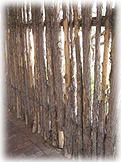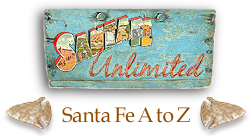|
|||
La Fonda Hotel Once a famed Harvey House, the La Fonda Hotel was built in 1922, on the site that was known as the end of the Santa Fe Trail. This historic adobe architectural masterpiece and landmark is one of the most popular destinations for locals and tourists alike. Many special events are held at this beautiful, historic hotel throughout the year. The La Fonda Hotel is located at 100 East San Francisco Street. (~Jean)  Land of Enchantment Land of EnchantmentThe official nickname of the state of New Mexico, given for its stunning beauty and the sacred place the land holds in the hearts of its people. (~Aimee) Latilla A sapling or small tree stripped of its bark and used in numerous building applications in the Southwest United States and Mexico. For example, latillas are laid side-by-side for ceilings as well as being used as fence posts. Latillas are also used in the popular "coyote fences" seen widely in Santa Fe, New Mexico. (~Aimee) Lizard A large, widespread group of reptiles with nearly 5,000 species, lizards range across all continents except Antarctica. Lizards typically have four limbs, external ears, and a long tail. Many species of lizards can detach their tails for the purpose of escaping from predators. Lizards are very common in the Southwest, often spotted climbing New Mexico's exterior adobe walls... and as decor, they can be found on interior adobe walls as well. (~Aimee)  A Bit of Lizard Rock Trivia: Rock icon, Jim Morrison (lead singer of the 1960s rock group, The Doors), was known as the "Lizard King." Jim Morrison's deep connection to shamanism often took form as iconography in his writing. In his lyrics for the epic performance/song Celebration of the Lizard, he would speak "I am the lizard king. I can do anything." This is the origin of the Lizard King moniker. Although several attempts were made to record Celebration of the Lizard, only one small section of it was released as Not to Touch the Earth on The Doors' third album, Waiting for the Sun. (~Aimee) A Bit of Lizard Rock Trivia: Rock icon, Jim Morrison (lead singer of the 1960s rock group, The Doors), was known as the "Lizard King." Jim Morrison's deep connection to shamanism often took form as iconography in his writing. In his lyrics for the epic performance/song Celebration of the Lizard, he would speak "I am the lizard king. I can do anything." This is the origin of the Lizard King moniker. Although several attempts were made to record Celebration of the Lizard, only one small section of it was released as Not to Touch the Earth on The Doors' third album, Waiting for the Sun. (~Aimee) Long Johns Long JohnsDefinition: “Underwear with closely fitted legs that extend to the wearer's ankles, often with a long-sleeved top.” Long underwear, often called “long johns,” is a newer style of two-piece underwear with long legs and long sleeves that is normally worn during cold weather. It offers an advantage over the more old-fashioned version of long johns or “union suit,” in that the wearer can choose to use either the top, bottom, or both parts depending on how cold it is. The one-piece long johns, traditionally made of red flannel, was buttoned all the way up the front and had a button-up rear “access hatch” so the wearer could eliminate bodily waste without undressing. Depending on the size of the suit, some have the maximum of 11 buttons on the front, to be fastened through buttonholes from the neck down to the groin area. This warm and practical garment remained in common use in North America into the 20th century. As its popularity waned, it became chiefly working men’s wear. In the mid-1900s, it was not uncommon for rural men to wear the same long johns continuously all week, or even all winter. Normally, no other type of underwear was worn with it. One of the major events of the spring was when the union suits were removed washed, and put away for the summer. In films and television, wearing long johns was a sign that the character was completely out of touch with the modern world. For example, a funny scene in “Seven Brides for Seven Brothers” has the six brothers refusing to take off their long johns for their older brother’s new bride to wash. (~Jean)  A Bit of Personal Long Johns Trivia: With our inclusion of the term “long johns” in our A to Z directory, let it not be confused with the delicious donut-like dessert called by the same name. When I was a young girl, one of our favorite treats was the “long john” (donut dough bar) with chocolate or maple icing. My mother would get them from the bakery of a local discount market called “Big Giant.” And occasionally, my aunt would treat my cousin and I to a chocolate long john and a Grapette (in an icy-cold, tall glass bottle) when we would run errands in El Reno, Oklahoma. Although they taste exactly like donuts, the preference for a long john over a donut had to do with the fact that a long john was more substantial, and therefore, more satisfying than the average, somewhat puny donut. (~Jean) A Bit of Personal Long Johns Trivia: With our inclusion of the term “long johns” in our A to Z directory, let it not be confused with the delicious donut-like dessert called by the same name. When I was a young girl, one of our favorite treats was the “long john” (donut dough bar) with chocolate or maple icing. My mother would get them from the bakery of a local discount market called “Big Giant.” And occasionally, my aunt would treat my cousin and I to a chocolate long john and a Grapette (in an icy-cold, tall glass bottle) when we would run errands in El Reno, Oklahoma. Although they taste exactly like donuts, the preference for a long john over a donut had to do with the fact that a long john was more substantial, and therefore, more satisfying than the average, somewhat puny donut. (~Jean)Luminaria (or Farolito) The first luminarias in North America were bonfires of crisscrossed piñon boughs arranged in three-foot high squares. The Pueblo Indians in New Mexico have long made these small fires outside their homes to light their way to church on Christmas Eve. Later luminarias were small paper lanterns made from colored paper brought to this continent from the Orient. Instead of hanging these delicate lanterns from trees or on wires, they were placed on the ground, on rooftops and along pathways. Today, the word farolito is used in Northern New Mexico, while luminaria is used in Central and Southern New Mexico. Contemporary farolitos are small brown paper bags, filled with an inch of sand which supports a candle. At Christmas time, New Mexico streets and rooftops are lined with these festive lights. (~Aimee) Pictured top to bottom: 1} Latillas are used for coyote fencing throughout the Southwest; 2} A pair of long johns hang on the wash line |
|||
Home | Food | Lodging | Merchants | Services | Real Estate | Art & Galleries | Entertainment | Recreation Ski Areas | Mind-Body-Spirit | Santa Fe Information | Local Color | Canyon Road | The Turquoise Trail | Santa Fe Plaza The Pueblos | Scenic Beauty | Day Trips | Chili | Special Events | Santa Fe History | Multicultures | Museums High Road to Taos | The Wild West | Churches | Plants & Wildlife | Santa Fe Railyard | Turquoise | Architecture Fiesta | Indian Market | Spanish Market | Zozobra | Features | About Us | Get Listed! | Santa Fe Unlimited Trading Post Photo of the Week | Link of the Month | Testimonials | Santa Fe Webcams | Santa Fe Weather Santa Fe A to Z | Movie Locations | Santa Fe Unlimited Guestbook | Sitemap | Contact Us | Taos Unlimited All original graphics and content of this website, unless otherwise indicated, are copyright © 2006-2011 Santa Fe Unlimited and may not be reproduced in any fashion. |
|||

